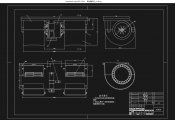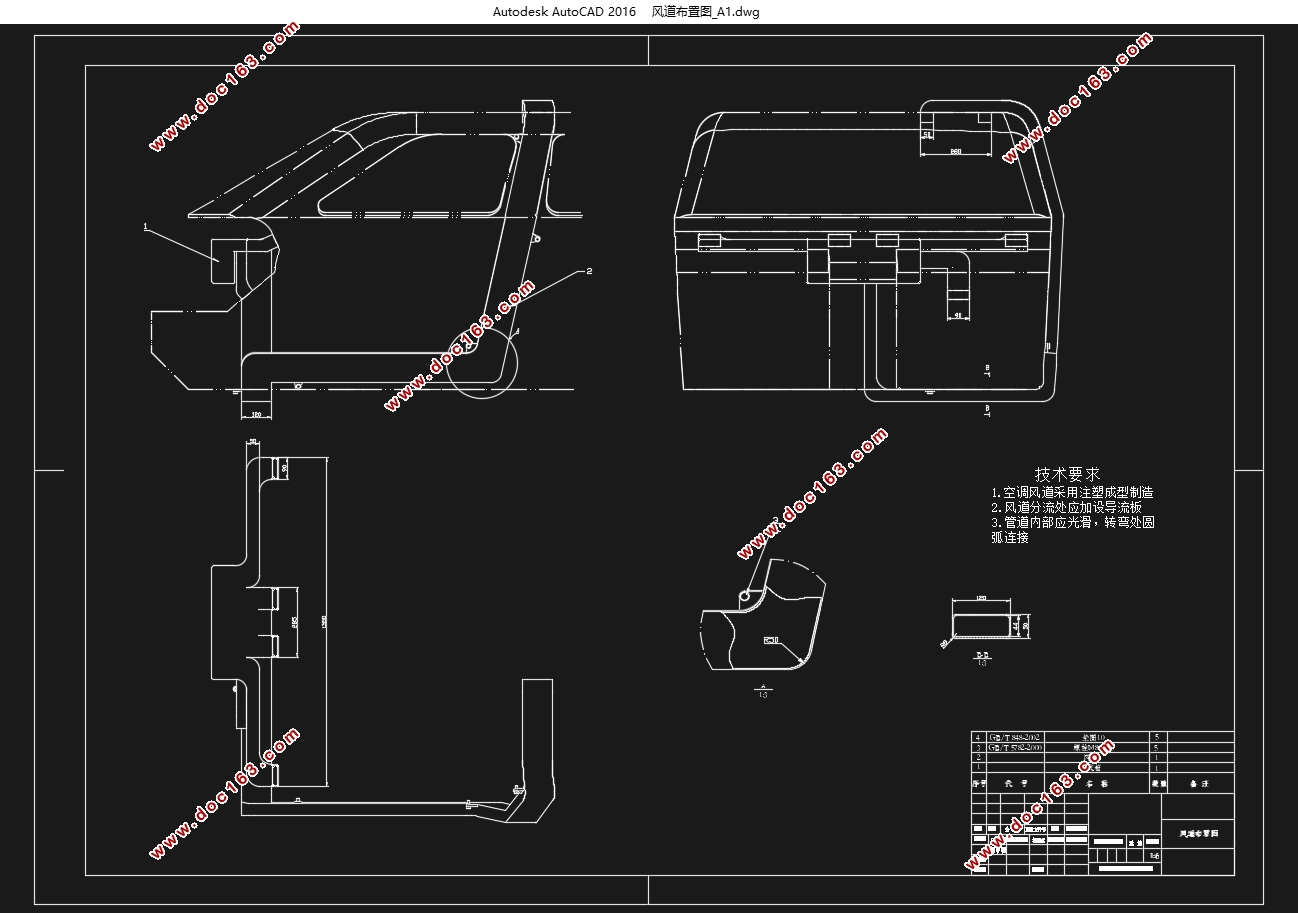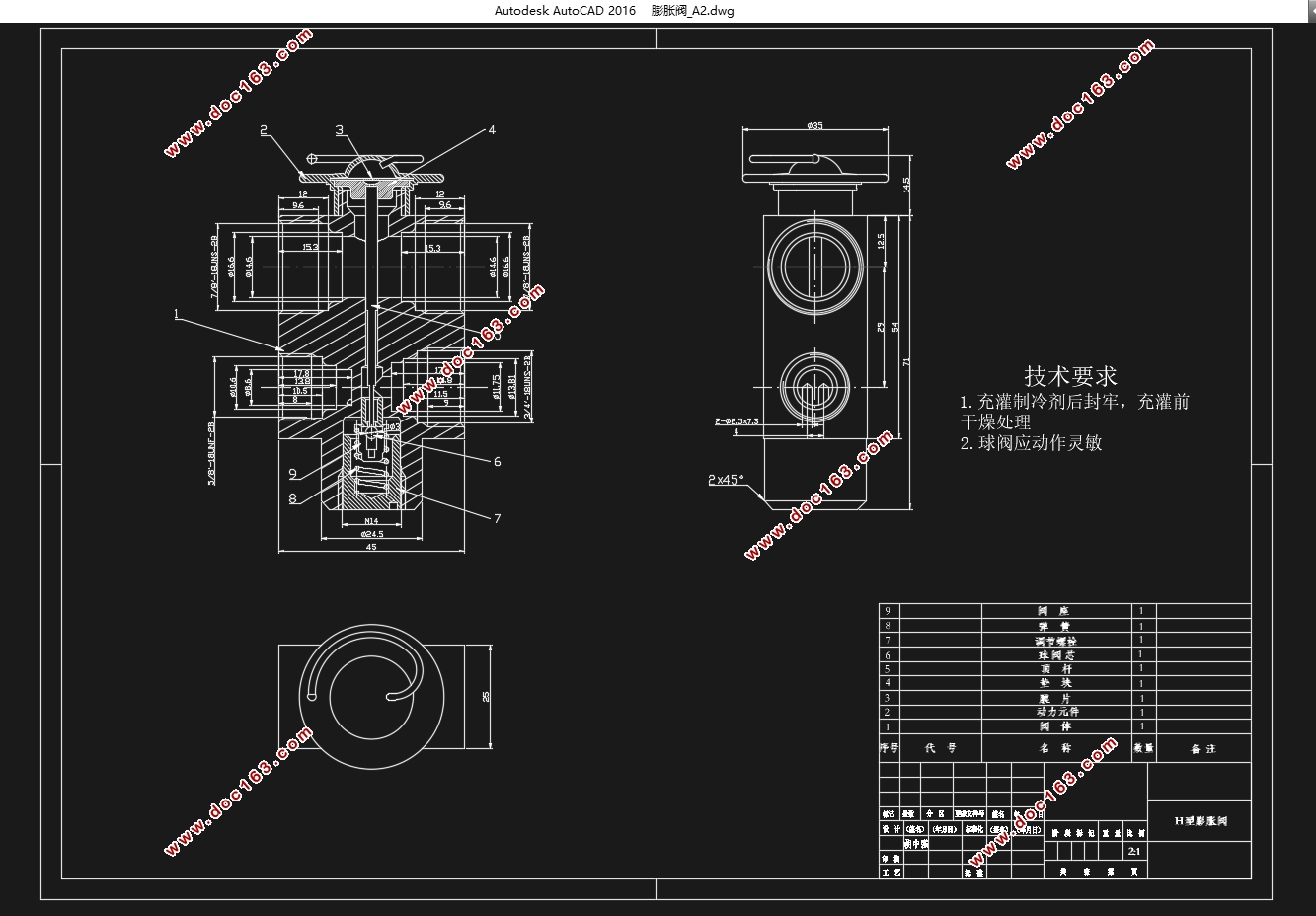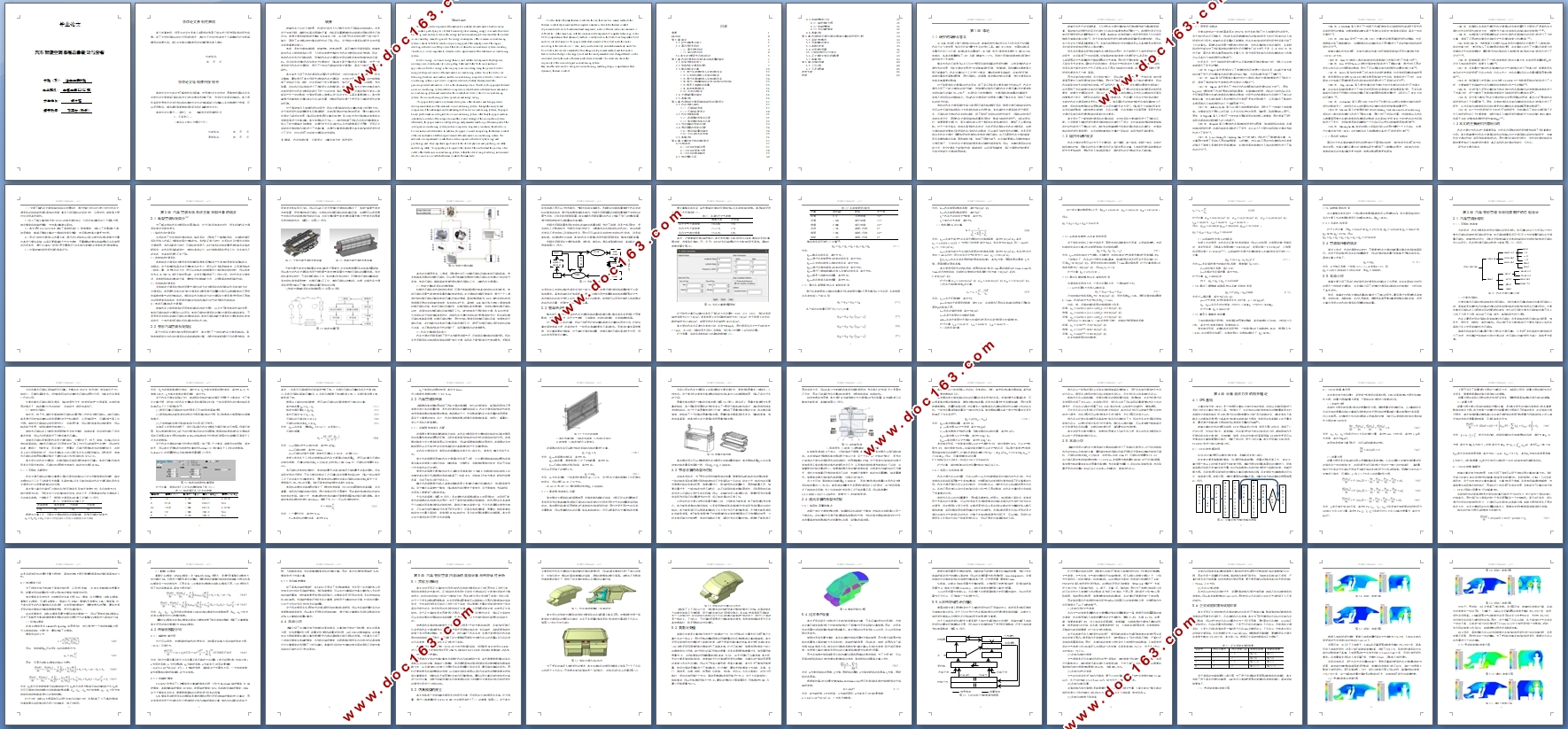汽车智能空调系统总体设计与分析(含CAD图)

汽车智能空调系统总体设计与分析(含CAD图)(任务书,开题报告,外文翻译,论文说明书30000字,CAD图3张)
摘要
随着汽车行业的飞速发展,汽车已经成为人们日常生活中不可或缺的组成部分。但是由于全球变暖、能源危机等问题越发严重,汽车保有量增加带来的能源与环境问题也不容忽视。普通空调系统的耗能大概在1kW-5kW之间,这占据了汽车发动机很大一部分动力输出,导致了在空调运转时整车动力性的下降。所以,关于传统空调系统的研究与改进具有非常重要的意义。
电能,是较为清洁的能源,随着水电、核电的发展,其可持续性也越来越好。随着电能在汽车上越来越多的应用,人们也在考虑把电能作为汽车空调系统的动力来源。现在,电动汽车技术已经越发成熟,而电动汽车的空调系统使用的就是由电池带动的电动压缩机。但目前来说传统汽车依然处于主要地位,所以本文基于传统汽车空调系统,仿照一些混合动力汽车的空调系统,提出了一种双压缩机的新型空调系统,具有一定的实用性与节能性。
本文首先介绍了汽车空调系统的国内外发展现状,分析对比各种不同空调系统的优点与弊端,最终提出了本文所研究的智能汽车空调系统,并对该空调系统的组成与控制策略做了详细的介绍。随后,对该系统的一些主要零部件,如压缩机、蒸发器、冷凝器、节流装置、风机和出风口结构进行了选型设计与参数匹配。除此之外,本文还针对改善车室内的热舒适性对汽车空调系统做出了进一步的改进。驾驶舱的舒适性对驾驶员的生理与心理都会产生一定的影响,对驾驶员的身心健康以及行车的安全性都具有重要的意义。本文希望通过改善传统空调风道与出风口的布置,使驾驶员能获得一个更符合人体热舒适性的驾驶环境。
[资料来源:https://www.doc163.com]
对于驾驶室内人体热舒适性的研究,现在主要有实验法和计算机仿真分析两种方法。由于热舒适性实验需要很多仪器与器材,车室内环境的控制也比较困难,同时计算机技术获得突飞猛进的发展,所以现在常常采用计算流体力学,即CFD技术对驾驶室的温度场与速度场等进行仿真计算。本文按照实车尺寸以1:1的比例构建了汽车内流场的仿真模型并加入了较为精确的人体模型,并通过改变出风口型式以及送风参数等可变因素,采用正交实验法对驾驶舱内流场进行了仿真计算,并通过计算得到的结果对其车室内的热舒适性进行了评价,对比说明了该新型空调系统的优越性。
关键词:汽车智能空调 匹配设计 计算流体力学 热舒适性
Abstract
With the rapid development of the automobile industry, the automobile has become an indispensable part of people's life. But because of global warming, energy crisis and other issues becoming more and more serious, the energy and environmental problems caused by the increase in car ownership cannot be ignored. The energy consumption of the common air conditioning system is about 1kW-5kW, which occupies a large part of the output power of the engine, resulting in the decline of the power of the vehicle when the air conditioner system is working. Therefore, it is very important to research on the improvement of the traditional air conditioning system.
Electric energy is a cleaner energy than oil, and with the development of hydropower, nuclear power, its sustainability is also getting better and better. With more and more applications of electric energy in the car, people are considering using the power of electric energy as the power source of the automobile air conditioning system. Now, the electric car technology has been more mature, and the air-conditioning compressor of electric vehicle’s air conditioning system is just electric compressor driven by battery. But at present the gasoline-powered automobiles is still in the dominant position. Therefore, this paper put forward a new air conditioning system with two compressors, which based on the traditional automobile air conditioning system and modeled on the some hybrid electric vehicle’s air conditioning system. The air-conditioning system is practical and energy saving.
This paper firstly makes a systematic description of the domestic and foreign present development situation of the automobile-air conditioning system. Through the analysis and comparison of the advantages and disadvantages of various air-conditioning systems, the paper finally put forward an intelligent vehicle air-conditioning system. After that, this paper made an introduction in detail of the composition and the control strategy of the air-condition system. Afterwards, this paper makes a lectotype design and parameter matching of the main parts of the intelligent air-conditioning system, such as compressor, evaporator, condenser, throttle device, blower and air-outlet structure. In addition, this paper is aimed at improving the thermal comfort of the car and makes a further improvement of the automotive air-conditioning system. The automobile compartment’s comfort has a certain impact on the driver's physiology and psychology, and it has important significance to the driver's physical and psychological safety and driving safety. This paper hopes to improve the layout of the air duct and the position of air outlet of the traditional air-conditioning system, so that the driver can get a driving environment which is more in line with the thermal comfort of human body.
For the study of human thermal comfort in the car, there are two mainly methods: the thermal comfort experiment and the computer simulation. Due to the thermal comfort experiment needs a lot of instruments and equipment, control of the car indoor environment is difficult too. At the same time, with the continuous development of computer technology, so the CFD (computational fluid dynamics) method is widely used in the field of car temperature field and velocity field analysis. This paper established a model of flow field inside the motor according to the real vehicle 1:1 ratio, and joined a relatively accurate human body mode. The flow field in the car was simulated by the orthogonal experiment method, and the variable factors such as the type of air supply inlet and the wind parameters were changed. Based on the calculated results, the indoor thermal comfort was evaluated. The result also shows the superiority of the new intelligent air-conditioning system.
Key words: automotive intelligent air conditioning, matching design, computational fluid dynamics, thermal comfort [版权所有:http://DOC163.com]
[资料来源:http://doc163.com]





目录
摘要 I
Abstract II
第1章 绪论 1
1.1 研究的背景及意义 1
1.2 国内外研究现状 2
1.2.1 国外研究现状 3
1.2.2 国内研究现状 4
1.3本文的主要研究内容与目的 5
第2章 汽车空调系统总体方案与制冷量的确定 7
2.1 新型空调系统简介 7
2.2 智能汽车空调系统提出 7
2.3 整车热负荷计算 10
2.3.1通过车身壁面传入车室的热负荷 12
2.3.2从发动机舱传入车室的热负荷 14
2.3.3通过车窗玻璃传入车室的热负荷 14
2.3.4通过门窗缝隙或新风传入车舱内的热负荷 15
2.3.5乘员人体散发的热量 15
2.3.6其他电器热负荷 16
2.3.7 车身总热负荷 16
2.4 空调制冷量的确定 16
[来源:http://Doc163.com]
2.5 本章小结 16
第3章 汽车智能空调系统组成部件的匹配设计 17
3.1 汽车空调压缩机 17
3.1.1 压缩机的选型 17
3.1.2 压缩机匹配设计 18
3.2 汽车空调换热器 21
3.2.1 冷凝器的选型与匹配 21
3.2.2 蒸发器的选型与匹配 22
3.3 节流装置的选型与匹配 23
3.4 通风装置的选型与匹配 24
3.4.1 鼓风机风量的确定 24
3.4.2 出风口形式的选择 25
3.5 本章小结 26
第4章 计算流体力学的相关理论 27
4.1 CFD基础 27
4.1.1 CFD的求解流程 27
4.1.2 CFD的基本方程 28
4.1.3 CFD的数值解法 29
4.2 湍流模型介绍 30
4.3 热辐射模型介绍 31
4.3.1 辐射传递方程 31
[资料来源:http://Doc163.com]
4.3.2 热辐射模型 31
4.3.3 太阳辐射模型 32
4.4 本章小结 32
第5章 汽车智能空调内流场的数值计算与热舒适性分析 33
5.1 实验方法概述 33
5.2 仿真模型的建立 33
5.3 离散化处理 35
5.4 边界条件设置 36
5.5人体热舒适性评价理论 37
5.6 正交试验安排与试验结果 39
5.7 本章小结 43
第6章 总结与展望 44
6.1 工作小结 44
6.2 不足与展望 45
参考文献 46
致谢 49 [来源:http://Doc163.com]
上一篇:486柴油机总体设计及气缸体设计(含CAD装配图,CATIA三维图)
